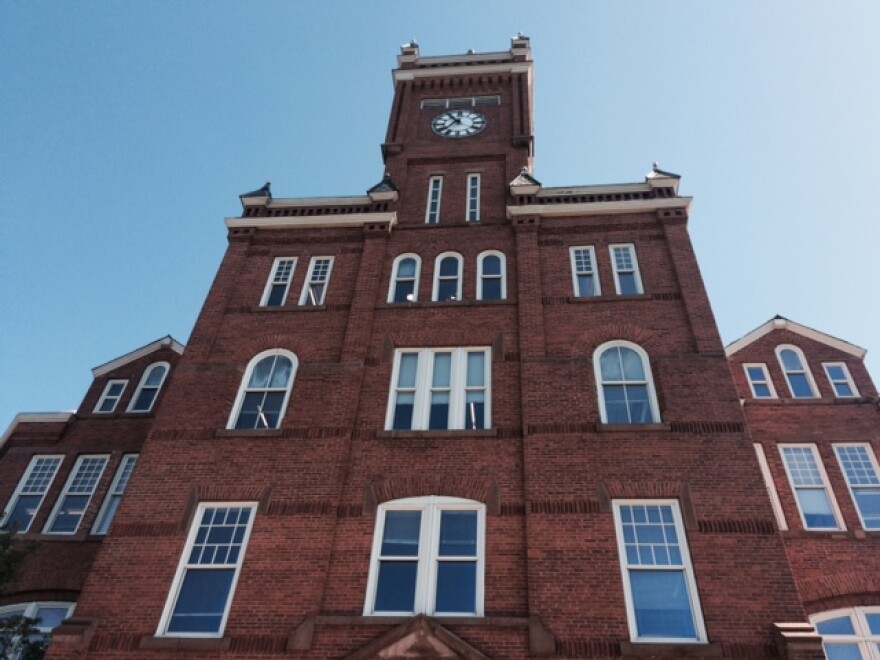Tom Hanchett is thought of as Charlotte’s historian, but his actual title is staff historian for the Levine Museum of the New South in uptown Charlotte. Since 1999, he’s witnessed, documented and told Charlotte’s story for the museum. Hanchett recently announced that he’ll be giving up his full-time post. That doesn’t mean he’ll stop working though.
When Hanchett first arrived in 1981, Charlotte didn’t seem like the most ideal place for a historian.
“People told me “Oh, you’re interested in history? You don’t want to be here. You want to be in Charleston. You want to be in Williamsburg,” says Hanchett.
But he chose to stick around.
“That got me annoyed and when you’re annoyed you dig in. Of course Charlotte has a history. People just hadn’t appreciated it.”
Hanchett’s work focuses on explaining Charlotte’s place in the New South. That’s the post Civil War era leading up to the present. He helped design the centerpiece of the Levine Museum, an exhibit called “Cotton Fields to Skyscrapers.”
It documents Charlotte’s rise from a largely textile community, through its civil rights struggles, and the spread of banking. In a city whose history is at times hard to see, it recreates the flavor of the past like a one-room tenant farmer’s house or the lobby of an early Belk department store.
“It’s a blessing and a curse. We tear down old stuff. It’s a city that can break your heart,” says Hanchett.
Some neighborhoods have kept a lot of the old buildings. Hanchett loves the chance to leave the museum to guide walking tours of areas like NoDa, Plaza Midwood, Biddleville and even neighborhoods where very few hints of the past remain.
To describe a past that’s hard to see, means being able to tell both an accurate and compelling story. Hanchett is often hit up by reporters for his ability to do so. He laid out the history of the Brooklyn neighborhood that once inhabited the city’s Second Ward for WFAE last year.
“Folks who are moving into the area just see parking lots and government buildings. But African Americans whose families are from this area see a history of pride and a history of heartbreak,” explained Hanchett.
The predominantly black neighborhood was demolished in Charlotte’s “urban renewal” period in the 60s. It was a vibrant community full of homes, businesses, schools, and even included one of the first free libraries for African Americans in the South.
“I’m thankful to Hanchett who will not let that story be shoveled under like all the houses that got demolished during that period,” says former Charlotte Mayor Harvey Gantt.
“He helps us to remember it and that's very important to my children and grandchildren who absolutely would have a hard time identifying where those neighborhoods were.”
Gantt says understanding its own story helps Charlotte become the great city it strives to be.
One of the first people to welcome Hanchett to town in the 80s was Dan Morrill, the Director of the Charlotte-Mecklenburg Historic Landmarks Commission.
“Tom has always had a spark of youthfulness in him. Tom’s a very, very engaging and positive person. I think the world of Tom Hanchett,” says Morrill.
Hanchett still sees the need to tell Charlotte’s story and that includes educating people on what’s going on now in city. Part of that is introducing people to different parts of the city they may not find on their own.
Las Delicias Bakery in east Charlotte is one of the places Hanchett and his wife bring people to on their food tours throughout the city. Its owner Zhenia Martinez says Hanchett has done a really good job of “bringing all the different areas of Charlotte together” from east Charlotte to Ballantyne and uptown.
Hanchett won’t exactly retire. He still plans to work for the Levine museum part time for awhile, but also do more community engagement activities like this. Once he fully retires, he’ll go from being a historian tied to a museum to a historian at-large.
For this interview, I asked Hanchett to meet me at his favorite place in Charlotte. We meet on the campus of the historically black school Johnson C. Smith University.

We stand in front of Biddle Hall, an impressive, brick, Victorian building built by African Americans in the 1880s when Charlotte was just a small town. But when Hanchett first set eyes on the campus he says the hall looked neglected.
“Now the birds are singing and the trees are in flower. Biddle Hall renovated under President Ron Carter recently is just a beautiful place to be,” says Hanchett smiling.
This campus he says, much like Charlotte, has evolved since he first arrived in the 80s. Hanchett now sees Charlotte investing in its future, partly by investing in its past. To a historian, that’s progress and a job worth doing.




